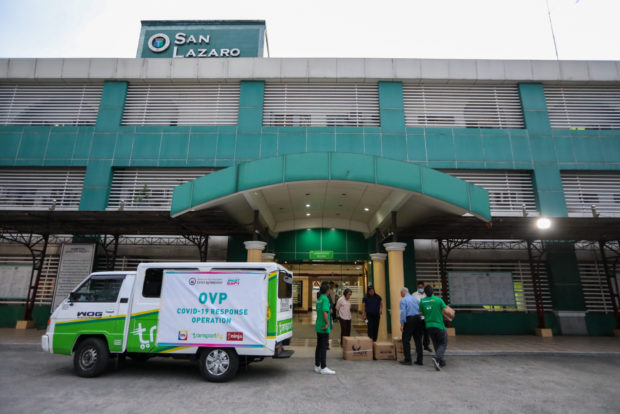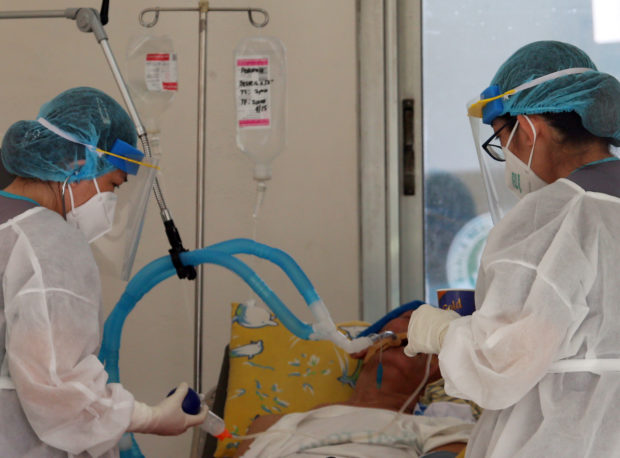Learning as they go: Doctors improve COVID-19 patient care
MANILA, Philippines — Tech entrepreneur Jorge “Jojy” Azurin was among those who fell severely ill with COVID-19 in the initial surge of cases in the country in March.
He spent eight days in the emergency room where he was intubated before he was transferred to the intensive care unit of The Medical City, where he stayed for another five days. In all, he spent 18 days in the hospital.
In a recent virtual forum on patient recovery from COVID-19 hosted by the Department of Health (DOH) Azurin, 56, related his struggle to survive.
“I knew I was dying,” he said. “I was putting a lot of mental, emotional, physical effort just to live.”
While fighting for his life early in his confinement, he was racked with worries about his wife and five children, fearing they might have also been infected.
But a simple note from his family saying everyone’s fine and healthy five days into his confinement helped improve his condition. He “started to feel better” and his doctor saw that, too.
“I started to have a surprise recovery. Another doctor confirmed that our story became the basis of the hospital to improve patient-family communication. It’s because it’s very helpful for a patient to know what is happening to your family, that they’re okay, so you can focus on your recovery,” Azurin said.
As part of a hospital’s safety protocol, COVID-19 patients are not allowed to receive visitors, even family members, to prevent further transmission of SARS-CoV-2, the virus that causes the severe respiratory disease. That leaves patients battling against both disease and depression on their own.
Dr. Jonas del Rosario, spokesperson for the Philippine General Hospital (PGH), describes COVID-19 as “a very isolating illness.”
“Most of the time you’re by yourself. You become depressed. Sometimes people can even take up suicidal thoughts because you start to feel and ask why you’re alone,” said Del Rosario, himself a COVID-19 survivor.
To improve patient care and provide psychological support, PGH set up in May its “Tele-Kumusta” program, which allows “face-to-face” encounters between patients and their families using the Zoom video conferencing app.
Del Rosario believes that the online meetups and several other refinements in patient management helped increase the number of recoveries, especially among the severely and critically ill.

PPE FOR SAN LAZARO Workers and volunteers unload boxes of personal protective equipment for the San Lazaro Hospital in Manila in this March 16, 2020, photo. San Lazaro is a front-line hospital fighting against COVID-19. —PHOTO FROM OFFICE OF THE VICE PRESIDENT
Adapting best practices
Five months after the outbreak, doctors at PGH and other hospitals have acquired more knowledge about the disease and adapted best practices here and abroad.
PGH now has a “template on how to approach patients systematically,” Del Rosario said.
While researchers are working on a vaccine, doctors and hospitals around the world have developed and shared innovative and effective modes of managing the disease and caring for patients that are less invasive, expensive and traumatic. They have also developed more prudent use of limited hospital or medical resources.
These lessons and experiences are learned and shared mostly through webinars and computer-assisted data collection, according to Dr. Rontgene Solante, chair of the Adult Infectious Disease and Tropical Medicine section of San Lazaro Hospital in Manila.
These new modes include putting severe COVID-19 patients in a prone position to aid breathing, using the investigational drug remdesivir, delaying intubation in patients to lessen trauma and sending home patients with mild cases to free up the beds in busy hospitals, Solante said.
“We listen to webinars among highly popular infectious disease specialists and pulmonologists abroad,” Solante said in an interview on Viber. “In short, what is being practiced in Western countries, we are using the same mode of management. There’s really an exchange of data that benefits the patient.”
Solante is the treasurer of the Philippine College of Physicians and a former president of the Philippine Society for Microbiology and Infectious Diseases. He is a consultant at Medical Center Manila, Adventist Medical Center and University of the East Ramon Magsaysay (UERM) Memorial Medical Center and an assistant professor at UERM Memorial Medical Center College of Medicine.
Solante said new guidelines for patient care were made “in collaboration” with the Philippine College of Chest Physicians, which also gets guidelines and references from the American College of Chest Physicians.
Preferred position
He and fellow infectious disease specialists constantly check with and collate data from the Infectious Disease Society of America on managing COVID-19 patients.
Doctors abroad report that putting patients in a prone position helps raise the level of oxygen that enters the lungs. While patients lay on their backs, part of their torso’s weight bears down on their lungs, making it more difficult for them to breathe.
That mode is now “part of standard care” for moderate, severe and critical patients, Solante said.
Del Rosario said patients at PGH are being placed in prone position every two hours, at least.
“When you have COVID-19 pneumonia, there are areas in your lungs which are collapsed or filled with secretions. If you do a prone position, it is the best way to expand [your lung] and get air into it versus lying on your back or side,” he explained.
“Remdesivir, an American “investigational drug” used in clinical trials in many parts of the world, has not yet been approved for general distribution.”
But medical journals report that the drug inhibits viral replication. In a webinar series on patient care, Solante reported that San Lazaro had been using remdesivir as part of the solidarity clinical trial of COVID-19 treatments.
PGH also hosts clinical trials of remdesivir and the Japanese antiflu drug Avigan as a possible cure for COVID-19.
Earlier, hydroxychloroquine and lopinavir/ritonavir were part of the trials but DOH stopped their use after the World Health Organization (WHO) found that these drugs did not help improve the condition of hospitalized patients.
Plasma therapy
PGH also uses convalescent plasma therapy, which makes use of the antibodies found in the blood plasma of a patient who had recovered from COVID-19. It was employed in mid-April only in patients who had undergone every possible intervention.
Del Rosario said they had learned that it was “more advantageous” if the plasma were given before the moderately severe condition of a patient worsened.
“We observed that if you give it late, there are already so many complications. So we created a new protocol where we try to give it earlier, even to those who are moderately ill. It was found out that the sooner you give it, within the 14 days, that’s the best time to give the convalescent plasma,” he said.
According to Solante, dexamethasone, a corticosteroid drug used to treat chronic obstructive lung disease, is another medication that Filipino doctors administer to COVID-19 patients.
He said dexamethasone was “initially not recommended” for COVID-19 patients because it was observed that in patients who had severe acute respiratory syndrome (SARS), the drug “prolonged the stay” of SARS-CoV-1, the virus which killed more than 700 people in an outbreak in 2002-2004.
“But with new evidence showing it helps decrease lung inflammation and helps prevent intubation among SARS-CoV-2 (novel coronavirus) patients, it is now recommended,” Solante said.
Solante said Philippine physicians use remdesivir and dexamethasone following updated clinical guidelines from abroad and WHO.

VENTILATOR A COVID-19 patient lies sedated while connected to a mechanical ventilator that helps him breathe. Several months into the pandemic, more hospitals are using the less invasive high-flow nasal cannula machine that delivers oxygen to the lungs through the nose. —EDWIN BACASMAS
Multiple experts now needed
Both Solante and Del Rosario said that a COVID-19 patient now required the attention of multiple medical experts, not just pulmonologists but also infectious disease specialists, cardiologists, endocrinologists, nephrologists and neurologists.
Previously, doctors at PGH had to first determine what particular test a person with COVID-19 needed to undergo, unlike these days when a patient would be immediately subjected to a battery of tests.
“That in itself is already a big improvement in the delivery of care because we have taken care of all the possible problems that can happen,” Del Rosario said.
“In COVID-19, it’s very important that you try to pinpoint the problems right away so that you don’t allow it to progress to a point that complications may set in,” he added.
Solante said that based on experience over the past months, COVID-19 not only caused pulmonary complications but also cardiovascular and others.
“Now every time a patient is admitted, there is always a multispeciality involved,” he said. “The more complications you have, the more specialists are needed in the team.”
Delaying intubation
One important intervention that was found more effective and less damaging on the patient was the use of high-flow nasal cannula (HFNC) machines instead of mechanical ventilators, which was used in the early days of the outbreak and on Azurin back in March.
Based on a review by a team of PGH experts of the practices at other hospitals, Del Rosario said it was found that it was better to delay the use of a mechanical ventilator and rely on the HFNC instead.
Del Rosario himself used that machine, which delivers a higher flow of oxygen to the lungs through the nose.
Currently, PGH has 22 HFNC machines. Del Rosario said that with HFNC, they prevented at least 70 percent of their patients from being intubated.
Delaying intubation is probably the innovation for which patients with severe COVID-19 cases are most thankful for.
To use a ventilator, an endotracheal tube is inserted through the mouth and into the patient’s airway, a very uncomfortable and traumatic experience that necessitates a patient being put under full sedation. The ventilator pushes air into the lungs and assists in respiration.
But the process is not entirely safe. The tube could be mistakenly inserted into the esophagus and could pump air into the stomach instead of the trachea. An erroneously inserted tube could also cause vomit or saliva to pool into the lungs and cause pneumonia.
There are also cases where the tube causes damage to the mouth, teeth, tongue, or larynx.
Costly antibiotics
“Also when you intubate, you increase the occurrence of a secondary infection,” Solante said, noting that antibiotics for a secondary infection are very expensive, costing as much as P10,000 to P15,000 each.
“And these are taken three times a day. Imagine a patient in a private hospital that charges P30,000 a dose. If you’re wondering why the government hospitals are always full, it’s because many patients don’t have enough to pay for the medicines. Even we doctors can’t afford that,” he said.
Solante said that on the average, a COVID-19 patient could spend between P1.5 million and P2 million for one to two weeks’ stay in a hospital.
Azurin told the Inquirer his 18-day hospitalization cost him between P1.2 million and P1.5 million.
Solante said he knew of a patient whose hospital bill amounted to P5 million and still did not survive early in the pandemic. But that patient benefited from full coverage from Philippine Health Insurance Corp. (PhilHealth).
These days a “critical” patient could only get P788,000 and one who is “severe” can receive “around P400,000” from PhilHealth, Solante said.
He strongly advised people who feel any symptoms to be immediately examined.
“This goes especially for those with immunocompromised conditions like hypertension. Even if the symptoms are mild, go to the hospital and be treated so you can avoid complications,” he said.
It was the same advice from Del Rosario.
“Because when patients come in much later, especially those with comorbidities, the elderly, they are sometimes already in the more complicated stage of the disease. It’s harder to get them out of that. So the sooner we can diagnose COVID-19, the faster we can help them,” Del Rosario said.